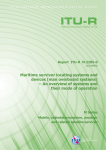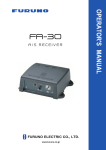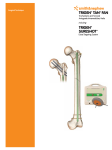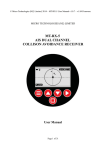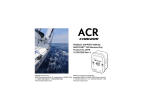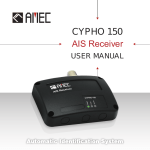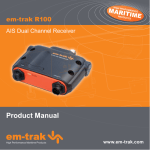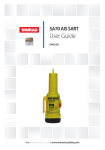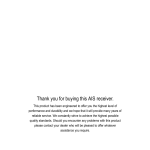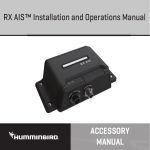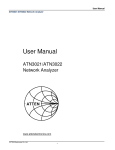Download NSR_NAS1000_Manual
Transcript
NAS-1000 AIS-SART USER’S MANUAL NEW SUNRISE NAS-1000 OM.E 20130626-04 NOTICE TO USERS - Thanks for your purchasing this product NAS-1000 AIS-SART. - Please read this manual carefully to ensure proper use before installation and use of the NAS-1000. - NEW SUNRISE will assume no responsibility for the damage caused by improper use or modification of the product or claims of loss of profit by a third party. - NEW SUNRISE reserves the right of continuous improvement on products both in software and in hardware without any prior notice. - The copyright of this manual is owned by the manufacturer, NEW SUNRISE. Prior written permission is required for copying or reproducing the manual or part of the manual. - Please keep the manual for your future reference. WARNING The battery should be replaced when the marked expiry date is reached. Dispose the lithium batteries carefully. Lithium batteries should have two poles insulated prior to disposal because the remaining power could cause severe harm to human beings. Local regulations should be followed when batteries are disposed in order to protect your environments. NAS-1000 OM.E 20130626-04 HOW TO ACTIVATE NAS-1000 1. Take off NAS-1000 from the installation bracket. 2. Pull off the red pin and move the operation handle to ON. 3. Check the LED indicator. While LED flashing, NAS-1000 is activated but GPS position is not available. While LED steadily on, GPS position is available. 4. Check the sound of the internal buzzer. An audible beep suggests a message is being transmitted. Usually a burst of eight short beeps can be heard per minute, which suggest eight messages are transmitted every minute. 5. Hold NAS-1000 in a vertical position to maximize the transmitting efficiency. 6. Keep NAS-1000 as high as possible by using the telescopic pole supplied or hanging NAS-1000 in the life raft by using the rope supplied. WARNING: Do not activate the NAS-1000 unless in case of emergency. If the NAS-1000 is activated for any reasons, except for short tests, the battery pack in NAS-1000 should be replaced to maintain enough life of batteries. The red pin should also be replaced because it cannot restore to its right state after being pulled off. NAS-1000 OM.E 20130626-04 Table of Contents 1. HOW TO ACTIVATE ........................................................................................... 2 1.1 ON VESSEL .................................................................................................... 2 1.2 IN LIFE RAFT ................................................................................................. 3 2. HOW TO TEST ................................................................................................... 4 3. HOW TO MOUNT ............................................................................................... 6 4. PERIODIC INSPECTION .................................................................................... 7 4.1 EVERY SIX MONTHS .................................................................................... 7 4.2 EVERY FIVE YEARS ..................................................................................... 7 5. HOW TO REPLACE BATTERY ........................................................................ 8 5.1 BATTERY REPLACEMENT ............................................................................ 8 5.2 BATTERY DISPOSAL ..................................................................................... 8 6. TECHNICAL SPECIFICATIONS ......................................................................... 9 CHECK LIST BEFORE DELIVERY ..................................................................... 10 INSPECTION RECORDS (EVERY 6 MONTHS) ............................................ 11 INSPECTION RECORDS (EVERY 6 MONTHS) ............................................ 12 INSPECTION RECORDS (EVERY 5 YEARS) ............................................... 13 INSPECTION RECORDS (EVERY 5 YEARS) ............................................... 14 MEMO...................................................................................................................... 15 APPENDIX SIZE DRAWING ............................................................................... 17 NAS-1000 OM.E 20130626-04 NAS-1000 MANUAL PRODUCT OUTLINE AIS-SART is an emergency device used for life raft. When activated, AIS-SART will transmit messages to indicate the position of AIS-SART. The vessels and rescue planes nearby can receive the position reports sent by AIS-SART to easily locate the life raft in distress. NAS-1000 AIS-SART conforms to the requirements set in IMO IMSC 246 (83). As a part of GMDSS, AIS-SART shares the same role as RADAR-SART (search and rescue transponder). RADAR-SART is used to locate a target by signal reflected to a radar. In this case, only rough position is read on radar screen with bearing. However, AIS-SART could provide accurate position with built-in GPS receiver, which can facilitate the rescue work greatly. AIS-SART transmits on dual channel, CH2087 and CH2088. The maximum communication range depends on both heights of transmitting antenna and receiving antenna. A=2.5(√H+√h) (nm) H and h refer to the heights in meter of antennas above sea. As required, AIS-SART should cover at least 5nm on the condition that transmitting antenna at lift raft is 1m high and the receiving antenna 16m high. Unique identifier (User ID) is used in AIS-SART to ensure the integrity of the VHF data link. The ID is programmed during production and marked on the case. The ID can not be changed after programmed unless done by manufacturer. The ID for an AIS-SART is 970xxyyyy, where xx=manufacturer ID, as 26 for NSR; yyyy =s/n set by manufacturer. For example, 970260008. When a position report is received with such a MMSI, together with safety message “SART ACTIVE”, it should be transmitted from an AIS-SART. NEW SUNRISE 1 NAS-1000 OM.E 20130626-04 NAS-1000 MANUAL 1. HOW TO ACTIVATE ① ② ③ ④ 1.1 ON VESSEL When still onboard the vessel, activate AIS-SART in below steps: Take off NAS-1000 from the installation bracket. Pull off the red pin and rotate the operation handle to ON. Check the LED indicator. While LED flashing, NAS-1000 is activated but GPS position is not available. While LED steadily on, GPS position is available. Check the sound of the internal buzzer. An audible beep suggests a message is being transmitted. Usually a burst of eight short beeps can be heard per minute, which suggests eight messages are transmitted every minute. Hold NAS-1000 in a vertical position to maximize the transmitting efficiency. Keep NAS-1000 as high as possible by using the telescopic pole supplied. To deactivate NAS-1000, rotate the operation handle to OFF. NEW SUNRISE 2 NAS-1000 OM.E 20130626-04 NAS-1000 MANUAL 1.2 IN LIFE RAFT Activate AIS-SART in life raft in below steps: Keep NAS-1000 as high as possible by using the telescopic pole supplied or hanging NAS-1000 in the life raft by using the rope supplied. Pull off the red pin and rotate the operation handle to ON. Check the LED indicator. While LED flashing, the transmitter is activated but GPS position is not available. While LED steadily on, GPS position is available. Check the sound of the internal buzzer. An audible beep suggests a message is being transmitted. Usually a burst of eight short beeps can be heard per minute, which suggests eight messages are transmitted every minute. To deactivate NAS-1000, rotate the operation handle to OFF. NEW SUNRISE 3 NAS-1000 OM.E 20130626-04 NAS-1000 MANUAL 2. HOW TO TEST Take off NAS-1000 from the bracket. Hold NAS-1000 in open space outdoor. Rotate the operation handle to TEST. Check LED status. If LED flashes, GPS position is not available. If LED steadily on, GPS position is available. Only when GPS position is available, NAS-1000 starts to transmit. If GPS position can not be available within 15 minutes, NAS-1000 will also transmit but with default position/COG/SOG. Usually GPS position can be available in one minute in open space. If GPS can not be available (LED flashes) after long time, NAS-1000 may be faulty. In such a case, please contact manufacturer or your local supplier for service. When NAS-1000 is transmitting, one burst of 8 short beeps can be heard, which suggests 8 messages be sent. Afterwards, one dash can be heard, which indicates that transmission is completed. Rotate the operation handle back to OFF. If the handle is still left on TEST position after the test, fast beeps will be heard to remind the operator to switch off the NAS-1000 immediately. Check whether the shipborne AIS MKD has received and displayed the message transmitted from NAS-1000. - Check the target list on MKD. There should be a target with the same MMSI as the USER ID. - A safety-related message “SART TEST” should be received from the same MMSI as the USER ID. Place NAS-1000 back to the bracket. Don’t pull the red pin when test. The red pin can not be restored to its original status after pulled. Pull the pin only when activate NAS-1000 in emergency. NEW SUNRISE 4 NAS-1000 OM.E 20130626-04 NAS-1000 MANUAL CAUTION: Even in low output power, NAS-1000’s transmission can be well received by vessels nearby. Frequent tests should be avoided not only for interference but also for battery-saving. NEW SUNRISE 5 NAS-1000 OM.E 20130626-04 NAS-1000 MANUAL 3. HOW TO MOUNT NAS-1000 is mounted with the wall bracket in the bridge. The bracket should be mounted in a vertical position and in a place where NAS-1000 is of easy access in case of an emergency. NAS-1000 is mounted in such a position to avoid direct sunshine and heating source. Fit the black bracket on the wall using four screws supplied, and then insert the NAS-1000 into the bracket. Before inserting NAS-1000, OPEN the cap of the pole, put the pole into the black hole on NAS-1000 from upside and then cover the cape on the pole. NEW SUNRISE 6 NAS-1000 OM.E 20130626-04 NAS-1000 MANUAL 4. PERIODIC INSPECTION Periodic inspection is very important to ensure AIS-SART in a good condition. Each test should be executed in short time because any test could reduce the life of the batteries. 4.1 Every six months The inspection every six months should be carried out by operators on board. The inspection should cover the following items: - Carry out test procedure by following HOW TO TEST. - Check whether any damage can be viewed. - Check the expiry date of the batteries. - Record the inspection result. 4.2 Every five years The inspection every five years should be carried out by manufacturer or authorized dealers. The inspection should cover the following items: - Replace the battery pack together with the case and gasket. - Check the watertightness of the case. - Carry out complete performance test. - Record the inspection result. NEW SUNRISE 7 NAS-1000 OM.E 20130626-04 NAS-1000 MANUAL 5. HOW TO REPLACE BATTERY 5.1 Battery Replacement The expiry date of the batteries is marked on the case of NAS-1000. The batteries should be replaced before the expiry date. The following items are to be replaced together: - Radome case of batteries (with operation instruction printed on the case) - Case cover - Colorless indicator cover - Gasket - Batteries All above items are combined into a battery module, NBT100. NSR guarantees the quality of NAS-1000 only when original NBT100 battery module is supplied by NSR. 5.2 Battery Disposal Warning:Lithium batteries should have two terminals insulated prior to disposal because the remained power could cause sever harm to human beings. Local regulations should be followed when batteries are disposed in order to protect your environments. NEW SUNRISE 8 NAS-1000 OM.E 20130626-04 NAS-1000 MANUAL 6. TECHNICAL SPECIFICATIONS ⑴ TX Frequency: AIS 1: 161.975MHz (CH2087) AIS 2: 162.025MHz (CH2088) ⑵ Carrier Power: 1W ⑶ Frequency Error: ≤0.5kHz ⑷ Communication Coverage: ≥5nm ⑸ Temperature range: Operating: -20℃ ~ +55℃ Storage: -30℃ ~ +70℃ ⑹ Size: 95(D)×377(H)mm ⑺ Weight: Abt. 900g ⑻ Battery: DC7.2V 96 hours operation in activation mode 5 years storage NEW SUNRISE 9 NAS-1000 OM.E 20130626-04 NAS-1000 MANUAL CHECK LIST BEFORE DELIVERY Battery: Expiry date: Watertightness verification: Mounting bracket: Transmission test: General operation: USER ID: NEXT INSPECTION DUE ON: Date: Signature and stamp: NEW SUNRISE 10 NAS-1000 OM.E 20130626-04 NAS-1000 MANUAL INSPECTION RECORDS (every 6 months) NO DATE NEW SUNRISE INSPECTION RESULT 11 INSPECTOR NAS-1000 OM.E 20130626-04 NAS-1000 MANUAL INSPECTION RECORDS (every 6 months) NO DATE NEW SUNRISE INSPECTION RESULT 12 INSPECTOR NAS-1000 OM.E 20130626-04 NAS-1000 MANUAL INSPECTION RECORDS (every 5 years) Battery replacement: Battery supplier: Model number: New battery expiry date: Old battery disposal: Gasket replacement: Performance test: NEXT INSPECTION DUE ON: Date: Signature and stamp: NEW SUNRISE 13 NAS-1000 OM.E 20130626-04 NAS-1000 MANUAL INSPECTION RECORDS (every 5 years) Battery replacement: Battery supplier: Model number: New battery expiry date: Old battery disposal: Gasket replacement: Performance test: NEXT INSPECTION DUE ON: Date: Signature and stamp: NEW SUNRISE 14 NAS-1000 OM.E 20130626-04 NAS-1000 MANUAL MEMO NEW SUNRISE 15 NAS-1000 OM.E 20130626-04 NAS-1000 MANUAL MEMO NEW SUNRISE 16 NAS-1000 OM.E 20130626-04 NAS-1000 MANUAL APPENDIX SIZE DRAWING NEW SUNRISE 17 NAS-1000 OM.E 20130626-04























